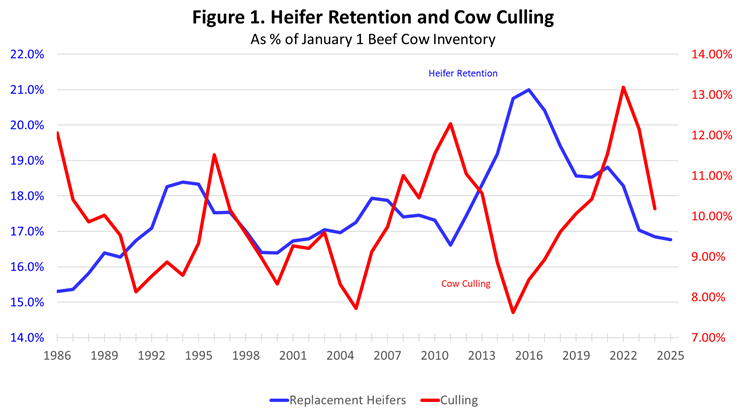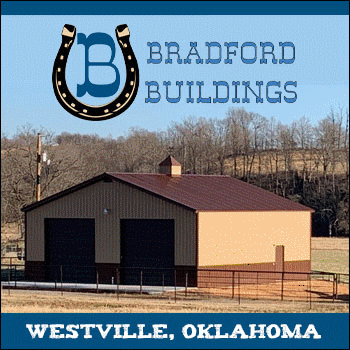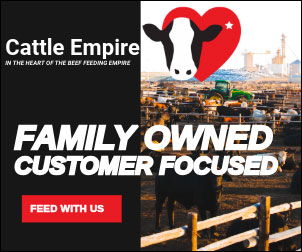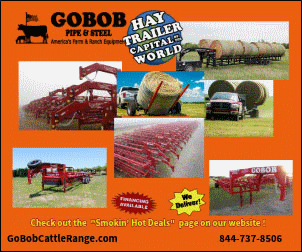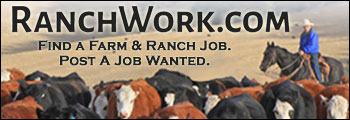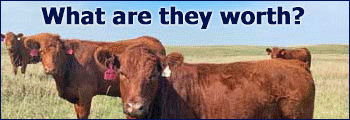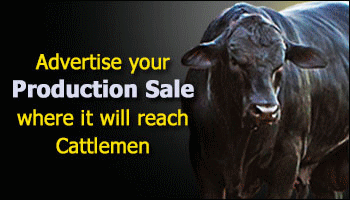Cow culling will determine herd dynamics in 2025; Heifer retention in 2025 can set the stage for some herd growth beginning in 2026.
Derrell S. Peel, Oklahoma State University
The latest Cattle report confirms what happened in 2024 – the cattle industry continued to shrink – but also provides indications of what to expect in 2025. Figure 1 above shows the basic drivers of beef cow herd dynamics. The graph shows heifer retention and cow culling, both as a percentage of the beef cow inventory. Simply put, beef herd expansion occurs when the blue line (heifer retention) is above the red line (cow culling). For example, this occurred dramatically in 2015-2018 with record high heifer retention and record low cow culling.
In 2024. Cow culling decreased sharply to 10.19 percent, about equal to the long-term average. It’s headed in the right direction but will need to drop further – 9.0 percent or below for two or more years - to indicate herd expansion. Even more critical is the heifer retention part of herd rebuilding. Figure 1 indicates that heifer retention has declined continuously since 2021 and has not yet begun to increase, as is required for herd expansion.
Prospects for herd growth in 2025 are very limited. Part of the replacement heifer inventory is the number of bred heifers available this year. That number was 2.92 million head, down 1.7 percent year over year and the smallest in data back to 2001. With this supply of bred heifers, cow slaughter will have to decrease at least seven percent year over year just to hold the beef cow inventory stable for the year. That would imply a cow culling rate of 9.3 percent for the year. A cow culling rate less than that will be required for even fractional herd expansion in 2025.
For 2025, the supply of bred heifers is mostly fixed. There is little that the beef industry can do to change herd growth prospects in the short run. The inventory of heifers saved for breeding was also determined in the Cattle report at 1.75 million head. These heifers can be bred to calve in 2026. Producers may decide to breed some additional heifers in 2025. This “impulse” breeding can augment the supply for bred heifers for 2026. Impulse heifer breeding was an important part of the rapid herd expansion from 2014-2019. This impulse heifer breeding would utilize heifers currently counted as part of the Other Heifer category in the 2025 cattle inventory. In other words, increased impulse heifer breeding will reduce available feeder cattle supplies on a one for one basis in 2025.
Cow culling will determine herd dynamics in 2025. It depends both on what producers are trying to do and what Mother Nature will let them do – drought is still a large threat. The beef cow herd could stabilize, decrease more or, perhaps, increased fractionally in 2025. Heifer retention in 2025 can set the stage for some herd growth beginning in 2026. The inventory of replacement heifers suggests that there are few plans for increased heifer breeding going into 2025, but impulse heifer breeding during the year may result in additional bred heifers for 2026. As with cow culling, it will depend on what producers are trying to do and whether drought limits those plans.
